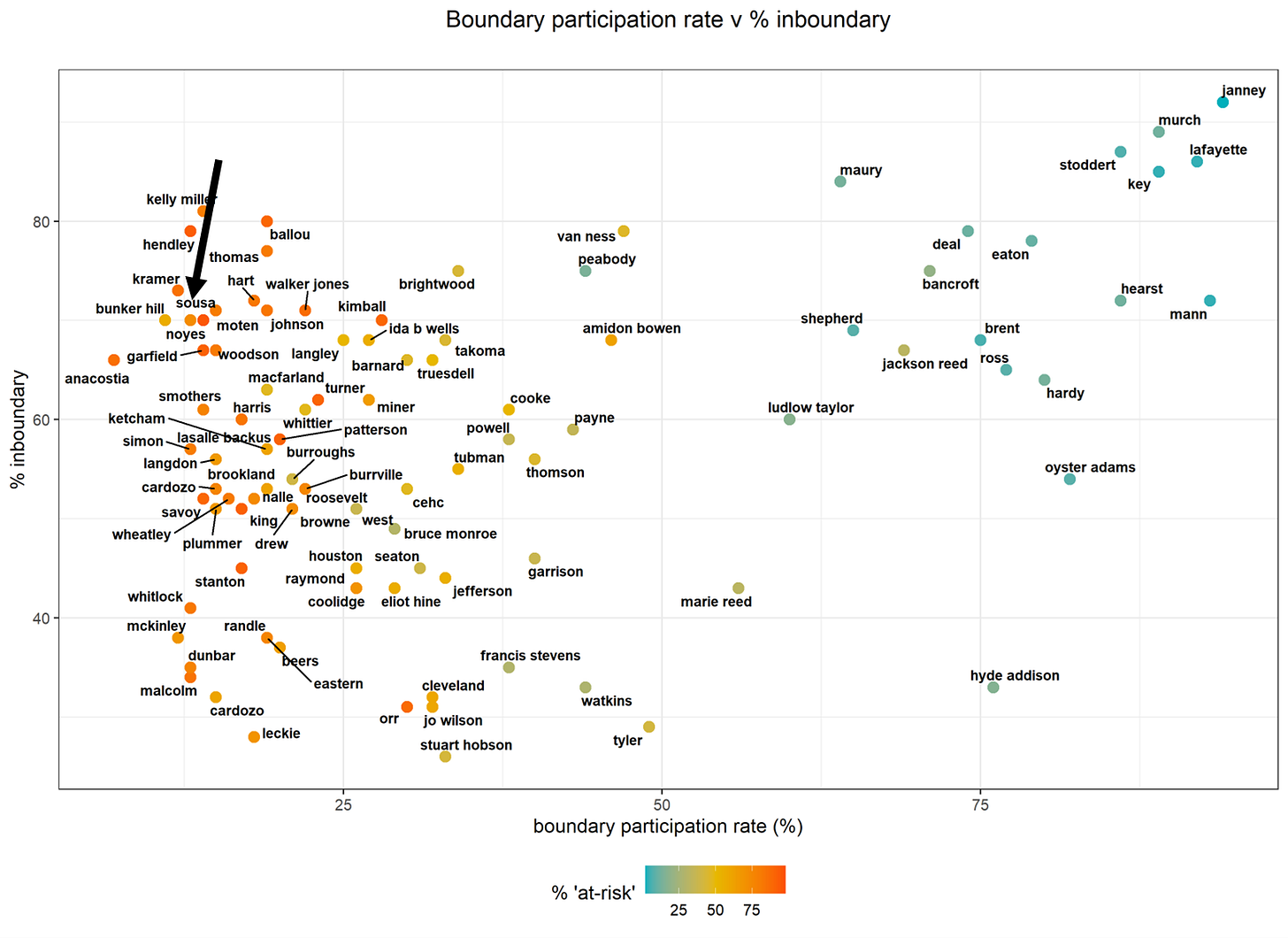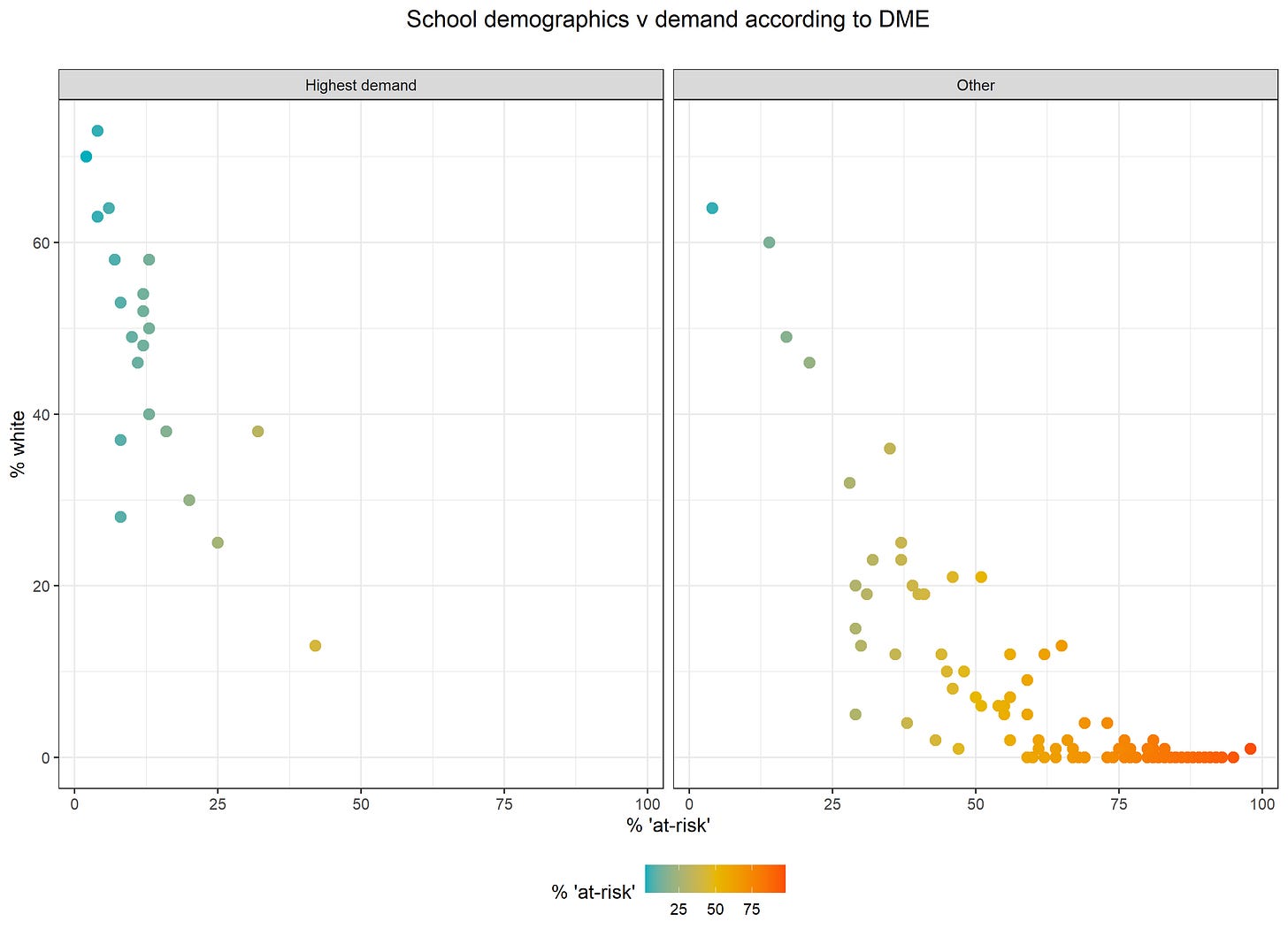As part of its boundary study, the Deputy Mayor of Education’s (DME) office held a community meeting on potentially closing or relocating Sousa Middle School in SE, which sent community members and parents scrambling to defend the school. Community members rightly pointed out that the school was being set up to fail due to lack of investment in the academic programs (and inequitable facilities) relative to the offerings available west of the river. Beyond offerings, continual school openings, closings, and reconfigurations in the neighborhood have also hindered schools’ ability to establish strong local communities and build on them. Afterall, a school is more than a building, it’s mostly about the people in it.
The DME uses data representing what percentage of students who live within the school’s boundary attend the school (boundary participation rate) to argue that the school has low demand. But let’s unpack this for a minute. Even if some students within the boundary decide to go elsewhere, what about the students who live in the boundary who attend the school? Don’t they matter too?
This graph shows that even though Sousa has a relatively low boundary participation rate, the majority of students (71%) attending Sousa actually live within the boundary. They may attend Sousa for a number of reasons, including that the school is closest to their homes and works best for their families.
Okay, but percentages can be misleading, what about the actual number of inboundary students attending Sousa? This graph shows that Sousa has a similar number of students attending from within the boundary as does Jefferson, Eliot Hine, and Stuart Hobson, but no one is talking about closing or relocating those schools. If we fundamentally believe that all students have equal value and deserve the same experiences, then why is the DME targeting only Sousa? Why are we so focused on the students who leave over the students who stay, and why are we selectively targeting schools in SE?
Okay, but what about the school quality? OSSE assigned Sousa a low school rating. Indeed, but Sousa is also overwhelming serving students from underserved communities and serving a greater share of students with greater levels of special education needs (level 3 and 4). We have no guarantee that students would fair better (or be welcomed) elsewhere, nor what the ratings of other schools would be if they were serving the similar student populations.
Because OSSE assigns school ratings in part based on which students attend the school, it’s somewhat of a circular problem. When school quality is partially defined as which students attend, any school serving too many underserved or special education students is likely to receive a low rating. (This is why charters opting into the “at-risk” preference in the My School DC Lottery offered relatively few seats for this preference.)
But we don’t have to define school quality in this way. If school quality was defined in terms of comparable resources (facilities, academic programming, etc.), then inequity in school quality in DC would be a solvable problem – just one for which there is no political will, as DC leaders have proven unwilling to provide the same level of resources in schools east of the river (EOTR).
Here’s how the DME defines schools in “high demand”, where they effectively define high-demand schools as those serving the most white students and the fewest students from lower income backgrounds. If this isn’t structural racism, I don’t know what is. Structural racism is when systems themselves further inequity, which is connected to but still distinct from racism that results from individual actions.
Instead of maintaining structural racism in its boundary process, here are things that the DME could do to potentially disrupt it:
Meaningfully adjust boundaries to increase racial/ethnic or socio-economic diversity when it makes sense geographically (even in Ward 3)
Limit out-of-boundary or citywide seats to students who would increase the racial/ethnic or socio-economic diversity for schools serving predominantly white or middle/high-income students (this could apply to charters too)
Invest the same level of resources (human capital, facilities, programming) in underserved and EOTR schools as those present in well-resourced schools – this doesn’t even get to equity, it just gets to equality
Involve the communities most impacted by the DME boundary process with authentic engagement and give them real autonomy in what happens to their schools, particularly in underserved communities








"Why are we so focused on the students who leave over the students who stay, and why are we selectively targeting schools in SE?" You nailed it, Betsy.